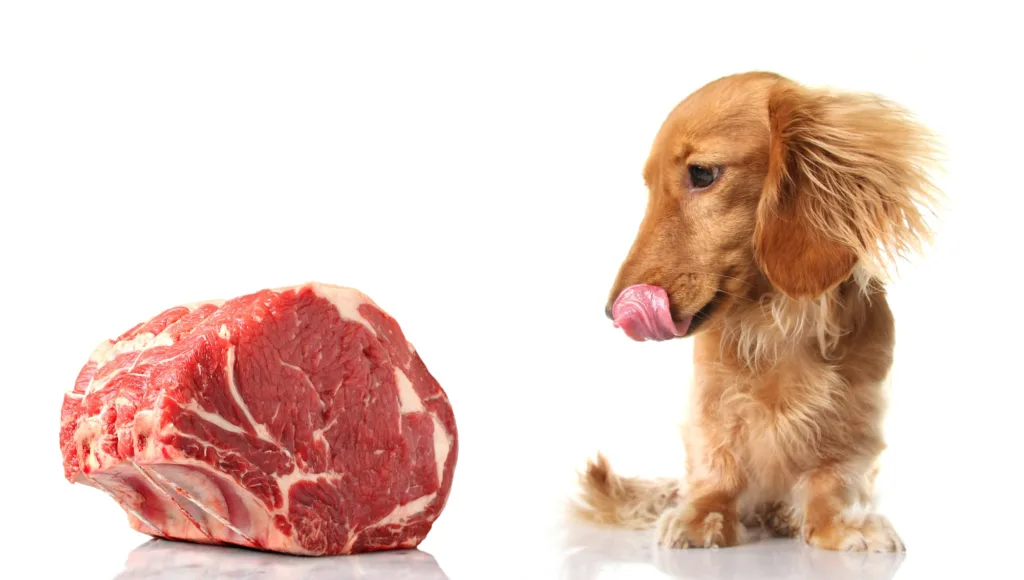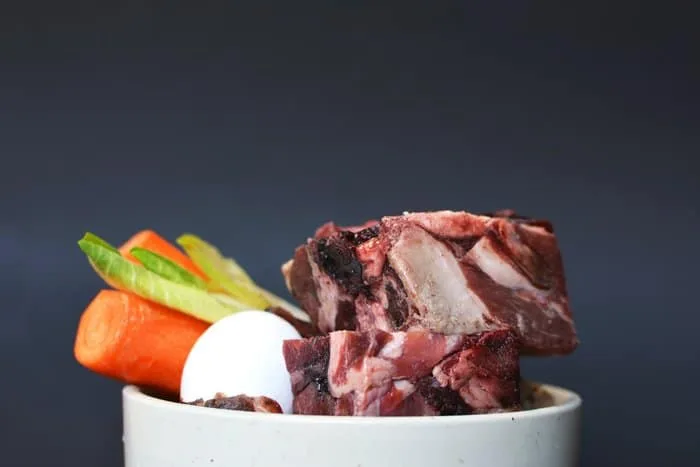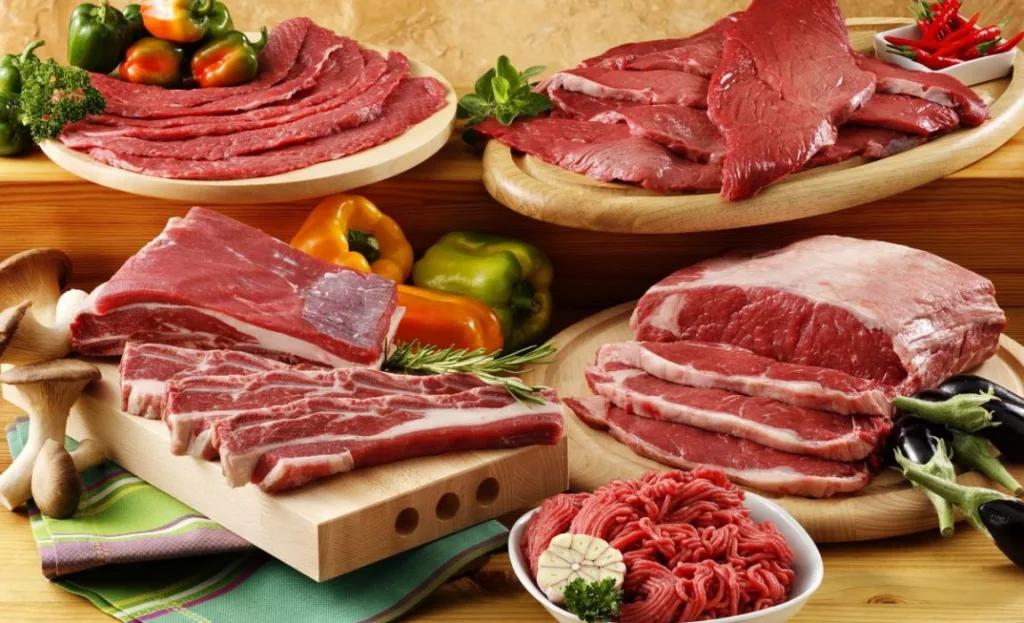A raw meat diet has become an increasingly popular choice for dog owners seeking to provide their canine companions with optimal nutrition. However, the idea of feeding raw meat to dogs can cause some initial hesitation. Misconceptions about foodborne illnesses along with concerns about proper handling may make some owners reluctant to make the switch.
This article aims to empower dog owners to serve raw meat with confidence by providing key information on the raw diet, discussing safe handling practices, and addressing common concerns. With the right knowledge and precautions, integrating raw meat into your dog’s diet can be done safely and successfully.

Introduction
Raw diets involve feeding dogs uncooked, unprocessed meats, bones, and organs rather than kibble or canned foods. These diets have gained favor due to perceived health benefits including shinier coats, healthier skin, cleaner teeth and increased energy. However, they require careful planning to provide complete nutrition while avoiding potential risks.
Proper handling and storage of raw meat is crucial to keep your dog safe. Simple precautions go a long way in mitigating concerns over foodborne pathogens. With some planning and care, most dog owners find that the benefits of raw feeding outweigh the modest risks.
Understanding the Raw Meat Diet
To start out on the right paw with raw feeding, owners should understand some key differences between the two main types of raw diets: biologically appropriate raw food (BARF) and prey model. We’ll also look at the nutritional requirements unique to dogs.
Benefits of a Raw Meat Diet for Dogs
Feeding raw meat, bones and organs provides nutritional benefits lacking in many commercial kibbles. Advocates point to improvements in:
- Dental health: Raw meaty bones help clean teeth and prevent plaque buildup.
- Digestion: Unprocessed food is easier to digest.
- Allergies: Raw diets eliminate potential allergens found in kibble.
- Weight: Some dogs naturally maintain a healthier weight on a raw diet.
- Energy: Raw food provides natural sources of energy like animal fat.
- Immune function: Raw diets include compounds that may boost immunity.
- Longevity: Anecdotally, some raw fed dogs enjoy longer lifespans.

Different Approaches: BARF vs Prey Model
While both diets involve feeding raw meat, bones and organs, the BARF and prey model diets have some differences:
- BARF diets aim to include vegetables and fruits deemed beneficial for dogs. CARBS
- Prey model diets focus solely on foods dogs would naturally eat in the wild: meat, bones and organs. NO CARBS
BARF diets allow more customization while prey model aims to mimic a natural ancestral diet.
Nutritional Requirements for Canines
Dogs have unique nutritional needs. While individual needs vary by breed, age and activity level, in general dogs require:
- Meat: Provides protein and fat for energy and muscle maintenance.
- Bones/Calcium: Essential for skeletal development.
- Organs: Supply key vitamins and minerals.
- Fatty Acids: Found in fish, omega fats benefit skin, coat and brain development.
With the foundations of raw feeding covered, let’s look at selecting quality ingredients.
Selecting High-Quality Raw Meat
Choosing high quality raw meat as the base for your dog’s diet ensures you are providing optimal nutritional benefits. Here are some tips for sourcing and selecting top-notch proteins.
Sourcing from Trusted Suppliers
The first step is finding reputable suppliers committed to high standards including:
- Human grade cuts: Meat rejected for human consumption may contain parasites or pathogens. Stick to quality cuts fit for human use.
- Sustainably farmed: Select suppliers that use ethical farming practices with healthy, humanely raised livestock.
- Organic/Grass-fed: These designations indicate higher quality meat and environmental stewardship.
- Locally sourced: Support small local farms near you for maximum freshness.

Types of Raw Meats Suitable for Dogs
Variety provides a spectrum of nutritional benefits. Rotate between muscle meats, rich organs and meaty bones.
- Muscle meat: Beef, chicken, pork, lamb, turkey, duck, rabbit. Leaner cuts are better than fatty.
- Heart and other organ meats: Liver, kidney, pancreas. Organs should not exceed 5-10% of total diet.
- Raw meaty bones: Chicken wings/necks, lamb necks, beef knuckles. Bones should make up 50% of meals.
- Fish: Salmon, mackerel, sardines. Choose wild caught fish rich in omega-3s.
Dealing with Variety in the Diet
To add diversity for balanced nutrition, rotate proteins every couple days. For picky eaters, introduce new proteins gradually mixed into old favorites. Consider grinds, which blend muscle, bone and organ into an easy to eat ground meat format.
Safe Handling Practices
Proper handling of raw meat is key to keeping your dog safe. Let’s review some best practices for storage, preparation and feeding.
Importance of Proper Storage
To avoid spoilage and foodborne illness:
- Freeze: Store meats frozen until ready to thaw. Freeze in daily portions for easy use.
- Thaw: Thaw meats in fridge, never at room temperature. Thawing can take 1-2 days so plan ahead.
- Sanitize: Keep preparation area and tools sterilized before and after use. Bleach solutions work well.
- Separate: Designate containers and sections of fridge/freezer for raw meats only to avoid cross-contamination.
Avoiding Cross-Contamination
Take steps to prevent spread of bacteria when handling raw meat:
- Hygiene: Use dedicated aprons, utensils and gloves. Wash hands thoroughly before and after.
- Separate: Never let raw meat, drippings or thawing liquid come in contact with other human foods.
- Clean: Immediately clean any surface raw meat touches with soap and hot water.
- Take caution: Dogs fed raw should not prepare or handle human foods. Young children and immunocompromised individuals should also avoid handling raw meat for dogs.

Thawing and Preparing Raw Meat Safely
Proper thawing and prep prevents loss of nutrients and potential for pathogens:
- Thaw: All meats should be fully thawed in the refrigerator or cool water – not at room temperature.
- Prepare: Use clean utensils on a sanitized surface designated for raw meats only.
- Portion: Avoid refreezing meats. Thaw only what will be used within a couple days and portion other meat into daily servings before freezing.
Follow safe meat handling procedures and the raw diet will pose minimal risks.
Transitioning Your Dog to a Raw Diet
Switching to raw is a big change. Follow these tips to help your dog easily transition.
Gradual Introduction to Raw Food
Make the change slowly over 7-10 days.
- Days 1-2: Replace 25% of kibble with raw meat.
- Days 3-4: Replace 50% of kibble with raw.
- Days 5-6: Feed 75% raw, 25% kibble.
- Day 7 and beyond: Feed 100% raw diet.
Mixing some familiar kibble with new raw foods keeps digestion regular during the switch.
Monitoring Your Dog’s Health and Progress
Pay attention to how your dog reacts over the first few weeks on a raw diet. Look for:
- Changes in energy levels, weight and digestion
- Differences in stool and urine
- Improvements in skin, coat, teeth and breath
- Any signs of potential food sensitivity or intolerance
Keep notes to help fine-tune the diet to your dog’s needs.
Common Challenges and How to Overcome Them
Some dogs struggle to adjust to raw diets. If challenges arise:
- Picky eaters: Mix in favorite kibble or toppings to entice picky dogs. Gradually decrease as they accept raw.
- Digestive upset: Try pre-mixing with probiotics or digestive enzymes. Too much bone can also cause constipation.
- Loss of appetite/energy: These are signs to check with your vet, as it could indicate food intolerance or imbalance.
Have patience through any transition bumps. Most dogs adapt to raw food with time.

Potential Risks and Precautions
While minimal, some risks are worth noting when feeding raw meat to dogs. Stay informed and take reasonable precautions.
Understanding Foodborne Illnesses
- Raw meats may harbor bacteria like salmonella or listeria. Dogs are shorter, more acidic digestive tracts make them less susceptible to foodborne illness than humans. Healthy canine immune systems are well equipped to handle common pathogens. However, take steps to minimize any risks.
- Puppies, seniors and immunocompromised dogs have higher risk. Cooked or lightly cooked meats may be safer options for these groups. Always consult your vet.
Recognizing Allergies and Sensitivities
When transitioning to any new diet, look for any signs of allergies or intolerances which may include:
- Vomiting, diarrhea, excessive gas
- Itchy skin, ears, paws or rear
- Hair loss, skin irritation, ear infections
If symptoms occur, remove problem ingredients and consult your veterinarian.
Balancing Raw Meat with Supplements
To create a fully balanced raw diet, additional supplementation may be required. Common supplements include:
- Calcium (ground eggshell, bone meal)
- Omega fatty acids (fish oil)
- Vitamin E, probiotics, digestive enzymes
Research proper holistic supplementation or seek advice from integrative vets or canine nutritionists.
Consulting with a Veterinarian
Veterinary guidance can help make raw diets safer and more balanced. Here are some topics to discuss with your vet.
The Role of a Veterinarian in Raw Diet Planning
Many holistic vets actively support raw feeding and can provide invaluable guidance on:
- Tailoring the diet based on your dog’s health and life stage
- Ensuring the diet provides complete nutrition without excesses or deficiencies.
- Recommending any necessary supplements.
Regular Health Checkups and Blood Tests
Schedule wellness exams with your vet every 6 months. Baseline blood work helps determine current health status. Ongoing blood tests identify any nutritional shortcomings of the raw diet.
Adjusting the Diet Based on Your Dog’s Needs
As your dog ages, nutritional needs evolve. Chronic conditions may emerge requiring dietary changes. Raw diets can be adjusted based on lab results and veterinary advice. Seek input whenever health changes arise.
While vets may not all fully endorse raw diets, an open and collaborative relationship benefits your dog’s health.
Success Stories and Testimonials
The proof is in the pets! Let’s look at some first-hand testimonials from dog owners who have seen dramatic improvements after switching their dogs to raw food diets.
Real-Life Experiences of Dog Owners
- “My dog struggled with stomach issues for years on kibble diets. After switching to a raw diet, her digestion improved within weeks. She has way more energy now and a shinier coat too.”
- “I was hesitant at first about handling raw meat, but it really isn’t difficult with proper precautions. My dog’s allergies have cleared up since we started raw feeding.”
- “My picky eater would barely touch his kibble despite trying expensive brands. He gobbles up his raw food with excitement. His teeth look so much cleaner now too!”
Positive Changes in Health and Well-being
Many owners report seeing the following benefits after transitioning to raw food:
- Relief of chronic digestive issues like diarrhea, constipation, gas and vomiting
- Shinier, healthier coats
- Improved dental health and decrease in doggy breath
- Increased energy and vigor, especially in older dogs
- Reduction in skin, ear and paw infections from allergies
Inspiring Stories of Dogs Thriving on Raw Meat Diets
- “My elderly dog struggled with arthritis and mobility issues for years. Since switching to a raw diet with glucosamine supplements, he runs and plays like a puppy again!”
- “My rescue dog had the worst case of mange the shelter had seen. After a raw diet with oils for skin repair, all his hair grew back glossy and thick.”
- “I was ready to give up on my dog’s chronic ear infections. Switching to raw finally resolved the issues that expensive medications failed to fix.”
These testimonials from real pet owners demonstrate the substantial benefits a natural, species-appropriate raw diet can provide.
Conclusion
For dogs, a species-appropriate raw meat diet offers many advantages over highly processed commercial kibble. Raw diets more closely mimic what canines would eat in nature. Dogs thrive when fed a variety of raw meat, bones and organs from quality sources.
With proper handling and reasonable precautions, raw meat can be safely fed at home. Make the dietary changes gradually and enlist your vet’s guidance to ensure peak nutrition. Be alert to your dog’s health and adjust the diet to meet their needs. Employ common sense meat safety, and your dog can reap the full benefits of raw feeding for a long and healthy life.
The concerns surrounding raw feeding are understandable. However, a little planning goes a long way to mitigate risks and feed your dog a diet aligned with their evolutionary needs. By making the switch thoughtfully and collaboratively, you can feel confident serving your cherished companion a diet that leaves them wagging their tail with vibrant health and happiness.
Ready to Learn More?
Are you interested in learning more about food, nutrition, health, wellness, and weight loss, not just for your canine companion but for yourself too? Subscribe to our free newsletter for a wide range of valuable insights and tips.
Looking for more articles related to food, nutrition, health, wellness, and weight loss? Explore our other posts to discover a wealth of information and guidance.
Thank you for reading this post, don't forget to subscribe to our free newsletter
!
